

Hands-On Astronomy Activities « Astronomical Society. Solar System Scale and Size. Super Planet Crash - Can you feel the gravity? Microsoft Word - scale_solar_system_geology - scale_solar_system_geology.pdf. Sunspots Activity: 1 of 5. Discipline: Science. Download NASA's Eyes. Curiosity_Landing_Site_2012.pdf. NASA Wavelength Digital Library. NASA Wavelength Digital Library. Mars Education. Marsbound! Mission to the Red Planet - JPL Education. By David Seidel David Seidel manages JPL's K-12 education program.
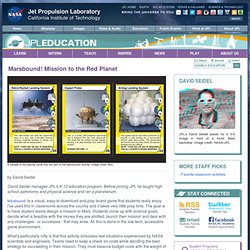
Before joining JPL he taught high school astronomy and physical science and ran a planetarium. Marsbound! Is a visual, easy-to-download-and-play board game that students really enjoy. I've used this in classrooms across the country and it takes very little prep time. What's particularly nifty is that this activity simulates real situations experienced by NASA scientists and engineers.
Student ability level: Students need to be able to add and subtract fractions, and multiply and divide whole numbers. Educational Resources « Astronomical Society. The Universe at Your Fingertips 2.0 « Astronomical Society. Purchase through the ASP’s AstroShop A Collection of Activities and Resources for Teaching Astronomy (on a DVD-ROM) Edited by Andrew FraknoiPublished by the Astronomical Society of the Pacific This DVD-ROM is the most comprehensive resource and activity guide for teaching basic concepts in space science ever published.

It includes: HESS-Teaching Resources - EHS-Manning. Unknown - 145916main_Astrobiology.Guide.pdf. 201304_NGSS-Wysession.pdf. SkyServer Basic Projects - Teachers' Guides. SkyServer Advanced Projects - Teacher's Guides. SkyServer Challenging Projects - Teacher'ss Guides. Our projects are designed to teach astronomy interactively, using the tools that professional astronomers use.
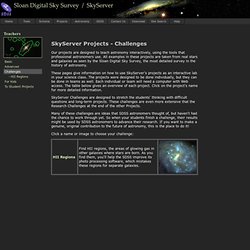
All examples in these projects are taken from real stars and galaxies as seen by the Sloan Digital Sky Survey, the most detailed survey in the history of astronomy. These pages give information on how to use SkyServer's projects as an interactive lab in your science class. The projects were designed to be done individually, but they can be done in teams as well. Each individual or team will need a computer with Web access. The table below gives an overview of each project. SkyServer Challenges are designed to stretch the students' thinking with difficult questions and long-term projects. Many of these challenges are ideas that SDSS astronomers thought of, but haven't had the chance to work through yet.
Click a name or image to choose your challenge: LSW Publications, Inc. - Publishers of Educational Materials specializing in Astronomy and Weather Topics. Hands-On Astronomy Activities « Astronomical Society. Education. PROJECT CLEA HOME PAGE. Simulation Curriculum Corp. — High School. A Short History of Nearly Everything by Bill Bryson. REBROADCAST: Space. Celebrate the 35th anniversary of the launch of Voyager 2 (it rocketed off Earth on 8/20/77 carrying a copy of the Golden Record), and tip your hat to the Mars rover Curiosity as it kicks off its third week on the red planet, with a rebroadcast of one our favorite episodes: Space.
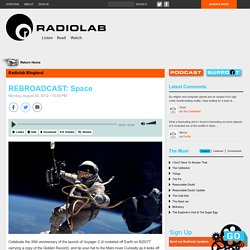
We've been space-crazy the past few weeks here at Radiolab -- from cheering on the scientifically epic landing of the Mars rover earlier this month, to staying up late to watch the Perseid meteor showers, to reliving a stomach-churning spacewalk with an astronaut in our live show In the Dark. We've been happily turning our thoughts and gazes skyward all summer long. So before the nights get too chilly, grab a blanket, cue up Space, and stare into that vast, glittering, perspective-shaking darkness with us. Dark Side of the Earth. 200 miles above Earth's surface, astronaut Dave Wolf -- rocketing through the blackness of Earth's shadow at 5 miles a second -- floated out of the Mir Space Station on his very first spacewalk.
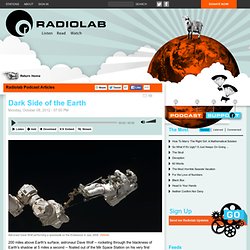
In this short, he describes the extremes of light and dark in space, relives a heart-pounding close call, and shares one of the most tranquil moments of his life. When we were putting together our live show In the Dark, Jad and Robert called up Dave Wolf to ask him if he had any stories about darkness. And boy, did he. Dave told us two stories that became the finale of our show. Back in late 1997, Dave Wolf was on his first spacewalk, to perform work on the Mir (the photo to the right was taken during that mission, courtesy of NASA.).
Oct10-moon phases. Astronomy Summary Sheet. Astronomy Simulations and Animations. The Universe at Your Fingertips 2.0 DVD-ROM: AstroShop. Killer Asteroids. The Sun. The Hazards of a Long Duration Flight. The Earth in Space HOT questions. HQ2TC271.PDF. Origins: Series Overview. Origins: Back to the Beginning September 29, 2004 NEIL deGRASSE TYSON (Astrophysicist): A hellish, fiery wasteland, a molten planet hostile to life, yet somehow, amazingly, this is where we got our start.
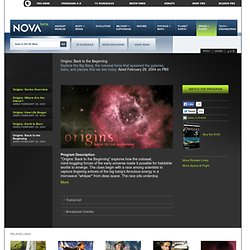
How? How did the universe, our planet, how did we ourselves come to be? Un-Manned Space Assignment - revised. Astronomy_Debate. GravityAndOrbitsLabActivity. Scale_solar_system_geology. MOON_OBSERVATION_ANALYSIS. MG_Tides of War_web.indb - MG_Tides of War.pdf. The NASA App for Smartphones and Tablets. Application Description The NASA App showcases a huge collection of the latest NASA content, including images, videos on-demand, NASA Television, mission information, news & feature stories, latest tweets, ISS sighting opportunities, satellite tracking, Third Rock Radio and much more.
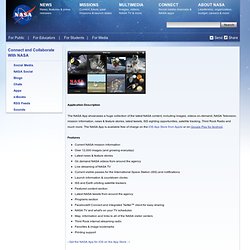
399149. The Universe at Your Fingertips 2.0 DVD-ROM: AstroShop. A Collection of Activities and Resources for Teaching Astronomy (on a DVD-ROM) Edited by Andrew FraknoiPublished by the Astronomical Society of the Pacific Wholesale and international orders please contact service {at} astrosociety.org or call customer service at 1-800-335-2624.
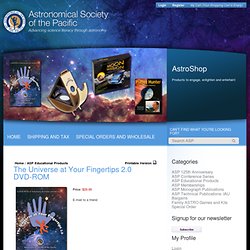
This DVD-ROM is the most comprehensive resource and activity guide for teaching basic concepts and activities in space science ever published. It includes: Download NASA's Eyes. Hands-On Astronomy Activities « Astronomical Society. Jewels of the Night. The Jewels of the Night is a hands-on, teacher-tested activity for middle school and older students.

Students measure the color and brightness of stars in the Jewelbox Cluster from a color image. They determine the age of the cluster by plotting their measurements in a color-brightness diagram. The activity develops classification and graphing skills and fosters observation, communication, and cooperative learning skills. Students are exposed to ideas about the nature of stars, temperature and color, stellar evolution, the time scales of astronomical phenomena, and how astronomers can determine the ages of objects in the universe.
The activity is designed to be printed for use in the classroom. STEM Lesson Plans. The Mars Education lesson plans section is here to serve as a resource for educators, grades K-12 to download and utilize in formal classroom settings.
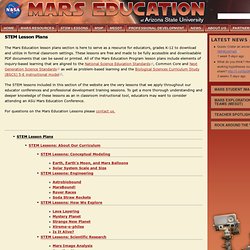
These lessons are free and made to be fully accessible and downloadable PDF documents that can be saved or printed. All of the Mars Education Program lesson plans include elements of inquiry-based learning that are aligned to the National Science Education Standards, Common Core and Next Generation Science Standards as well as problem-based learning and the Biological Sciences Curriculum Study (BSCS) 5-E instructional model.
The STEM lessons included in this section of the website are the very lessons that we apply throughout our educator conferences and professional development training sessions. To get a more thorough understanding and deeper knowledge of these lessons as an in classroom instructional tool, educators may want to consider attending an ASU Mars Education Conference. Astrobiobound. Astrobiobound! NEW - NGSS and CCSS Designed and Aligned! Students learn systems engineering by engaging in a mission planning simulation that mirrors the search for life in our solar system. Students create a mission that has to balance the return of science data with mission limitations such as power, mass and budget.
In this advanced and exciting activity, students in grades 3-12 will become NASA project managers and have the opportunity to plan their own NASA mission. Risk factors play a role and will add to the excitement in this interactive mission planning activity. Seeing in the Dark . For Teachers. When kids are asked for their favorite topics in science, astronomy (along with dinosaurs) is always high on the list. As a "gateway" to science education, astronomy is essential to the curriculum in many states and school districts. But even where astronomy is not required, it can often be a wonderful way to approach required science principles and ideas. Stellarium.
Astronomy_Debate. PROJECT CLEA HOME PAGE. Classroom-Ready Activities Matrix. Education. Bill Gates’ Great-Great-Granddaughter’s Honeymoon: An Astronomy Activity for Several Different Age Groups. When students finish a unit or course on the planets these days, they are often overwhelmed with facts, comparisons, and images. A good culminating activity, to help them organize their thinking (and review), is to have them divide into small groups (travel agencies) and come up with their top ten solar system “tourist sights” for future space vacationers, complete with images. 100,000 Stars" by Google Data Arts Team. A Six Minute Tour of the Known Universe. Universe Sandbox. A “sandbox” of the universe, allowing users to interact with and change almost any aspect of outer space while receiving detailed feedback on effects. Benefits of Play: Creativity, Innovation, Critical thinking, Content-specific Science, STEM, Educational Issue(s): scientific realism Platform: OS X, PC Cost: Free Publisher: Giant Army Game Trailer:
Moon Globe HD. How Far is it to Mars? Preview In-Vesta-Gate. « « Mountaintop Teaching | Wakeup, Rosetta! 2014 December 8 - Wanderers. The Earth-Sun-Moon System. Origin of the Universe and Our Solar System. Amazon. NOVA Labs. The Most Astounding Fact - Neil deGrasse Tyson. Copy of *A Star is Born - Winnie Litten. "We Are Star Dust" - Symphony of Science. Humans Really Are Made of Stardust, and a New Study Proves It. For decades, science popularizers have said humans are made of stardust, and now, a new survey of 150,000 stars shows just how true the old cliché is: Humans and their galaxy have about 97 percent of the same kind of atoms, and the elements of life appear to be more prevalent toward the galaxy's center, the research found.
The crucial elements for life on Earth, often called the building blocks of life, can be abbreviated as CHNOPS: carbon, hydrogen, nitrogen, oxygen, phosphorus and sulfur. Interstellar movie lesson. Science and Technology of WWII. So What is This About? Life Under a Rock: Bacteria in Extreme Environments. Reinventing the Wheel (for Mars)
CIMSS GOES-R Education Proving Ground. New analysis adds support for a subsurface ocean on Pluto: Findings suggest other large objects in the Kuiper belt may also have liquid oceans beneath frozen shells. A liquid ocean lying deep beneath Pluto's frozen surface is the best explanation for features revealed by NASA's New Horizons spacecraft, according to a new analysis. Lesson Plans. Lesson Plans. The Extrasolar Planet Encyclopaedia — Catalog Listing. Detailed age map shows how Milky Way came together. Using colors to identify the approximate ages of more than 130,000 stars in the Milky Way's halo, Notre Dame astronomers have produced the clearest picture yet of how the galaxy formed more than 13.5 billion years ago.
Astrophysicist Daniela Carollo, research assistant professor in the Department of Physics at the University of Notre Dame, and Timothy Beers, Notre Dame Chair of Astrophysics, along with research assistant professor Vinicius Placco and their colleagues published their findings in Nature Physics, including a chronographic (age) map that supports a hierarchical model of galaxy formation. Astronomy. Smart is the New Sexy - Timeline. Nov dec97 phases of venus. Oct10 moon phases. Dec06 the real shape of the moons orbit. Exploriments: Weight, Mass and Force of Gravity - Effect of Altitude and Comparison across Multiple Planets on the App Store. This Is What Earth Would Be Like Without The Moon. Educational Resources « Astronomical Society. A Year After Pluto. Comments. Which Came First on Earth. The solar system amazes me.
Scale of the Universe – Putting the universe into perspective. iReleaseEndorphins.